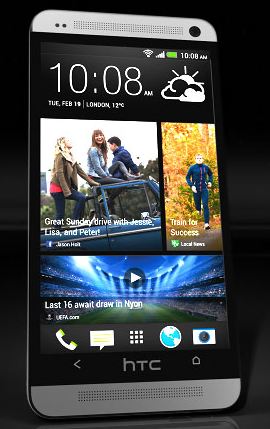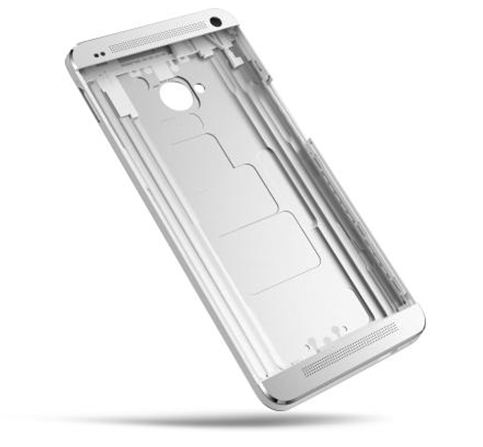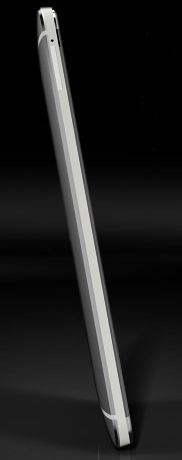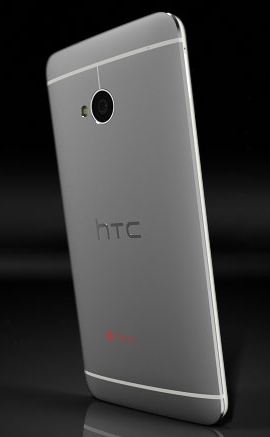It is amazing what putting a patent war behind it can accomplish for a company. Ever since HTC agreed to settle its patent differences with Apple, the company has managed to regain a good bit of the shine it had built for itself before it began to sink into an abyss from mid-2011 through most of 2012. First, the company emerged from the patent wars with the release of the HTC DNA – a most excellent large screen mobile phone. And now…
Today, HTC unveiled – in both London and New York City, its next true “statement” device – the HTC One, it’s entirely new Android-based flagship smartphone. The one immediate thing that screams out when you pick it up is its quality build – even before we get to the software parked within it, you have a new smartphone that, well, exudes the special feel of an Apple product. It is extremely well-designed – but actually we mean it is extremely well-built. It has that Apple “jewel” persona about it. No flimsy Samsung plastic feel to it anywhere.

That it also only feels slightly though undeniably larger than the iPhone 5 at 4.7 inches (vs. the iPhone 5’s 4 inch screen) is in itself an accomplishment. What we mean here, more specifically, is that although the phone is .7 inches larger than the iPhone 5, it doesn’t overwhelm you with a feeling of it being too big; it maintains the iPhone’s sense of “proper proportion” – no mean feat. A larger phone that doesn’t feel larger is a key to capturing the eye of the consumer – it is hardware that works – it doesn’t feel or look derivative but rather stands up on its own two feet and practically begs you to want to touch it.
We cannot state enough how important this is to delivering a successful product. BlackBerry’s new Z10 lacks all of this – it looks and feels derivative of something that came before it, whereas the HTC One feels entirely new. It is beautifully slimmed down but doesn’t feel awkward to hold. It has a gentle curve to the back that simply feels right – much as Blackberry’s original Curve did way back in 2006.
When it feels right you simply know it. And with the HTC One, you know it. Before we go on to the display, what makes it tick, as well as the software, we need to note and give applause to the One’s aluminum “unibody” design, shown below. There is absolutely no plastic anywhere to be had on the HTC One.

In total, the HTC One weighs in at five ounces – a full ounce heavier than the iPhone 5. The iPhone 5 retains its unbeatable and world class sense of overall “lightness of being”– in our opinion, it still manages to hold on to that sense of a perfectly sized phone, but as we noted with the display size comparison, the HTC One doesn’t suffer for it. The bigger screen but slim packaging – it measures .37” think compared to the iPhone 5’s .3” but the thing is that it tapers down to all of .12” at the edges – it allows it to feel lightweight despite its overall larger size.
The same can’t be said for the HTC DNA – which weighs the same, although it sports a five-inch display and is .03” thicker than the One – for whatever reasons, the DNA’s overall size simply gives a weightier impression (it’s harder to hold, and so there is an illusion of greater weight). Go figure. In the same vein, the Samsung Galaxy S3 is just a tiny bit thinner and a tiny bit lighter than the HTC One, and yet the HTC One wins the battle for feeling right here as well.


The Display and Camera
We’re going to punt on the camera today. Why? Well, the HTC One comes with “only” a 4 megapixel camera – which sounds like it would compare unfavorably to the Galaxy S3 and iPhone 5 – both of which deliver 8 megapixel cameras, as well as to the Nokia Lumia 920’s 8.75 megapixel camera. Ah well, there is more to pixels than what meets the eye, and the HTC One sports ultrapixels, not mere mortal pixels.
In short, HTC is taking an interesting approach – pixels that are twice the size of normal pixels packed into the same space that an 8 megapixel camera sensor delivers. We’ll return to the camera and its very interesting features under separate cover – and take a look at how it compares to the 8 megapixel cameras as well as Nokia’s Lumia and PureView 808 technologies.
Part of the charm of the design – working in tandem with the aluminum body, is the fact that the display practically takes up the entire front of the phone, save for two thin slices at the top and bottom – it has an iPhone-esque sort of look, only it actually achieves better minimalism than the iPhone does. This is part of the overall design allure we noted earlier.
The HTC One delivers 1080p video quality, and uses what the company refers to as SoLux technology, which HTC - not surprisingly - claims delivers improved picture quality. The screen itself offers 1,920 x 1,080 pixels, which means a 468 ppi display. The iPhone 5’s retina display delivers 1,136 x 640 pixels and 326 ppi. Suffice it to say, the screen looks great and gives up no ground to the iPhone display whatsoever.

The HTC One sports dual speakers, one each on either side of the screen – does this make a difference? Well, we don’t think so – it sounds like a smartphone playing music. The HTC One does provide Beats technology, so when you plug in the earphones, there may be a qualitative difference to some folks – we’re not among them (we are big speaker and big equipment audiophiles and big home theater electronics types so we admit we’re jaded on this front).
The Inner Workings
The HTC One comes with either 32 GB ($199 with two-year contract) or 64 GB ($299 with two-year contract) of RAM, and sports 2 GB of internal RAM – the iPhone 5 delivers only 1 MB of internal RAM. The phone runs Android Jelly bean 4.1, the same as the DNA, and utilizes a brand new 1.7 GHz quad-core Snapdragon 600 processor – Qualcomm’s best. The iPhone’s custom designed A6 processor is a dual core design. Both the HTC One and the iPhone deliver on LTE and HSPA+, so the user will get full 4G broadband capability where available. The One also delivers on NFC – as do all the key competitors with the exception of the iPhone 5.
The battery is an embedded 2,300 mAH battery, which will be plenty of power to drive the HTC One throughout the day. The iPhone 5 delivers a 1,440 mAH battery.
HTC delivers a newly refined version of its Layered Sense UI – although we are extraordinarily happy to see a few changes. For one, that HTC clock is now gone – and good riddance to it. Whether or not Sense offers anything of value will be entirely up to the user – as is usually the case for us, we don’t much bother with these.
However, as one will immediately note, there is one addition that does make a difference – a major difference that leaves the HTC One almost looking like a Windows Phone 8 phone with live tiles. HTC refers to it as BlinkFeed. It is a home screen UI that does in fact consist of dynamic tiles that is able to display content from a variety of sources - news, websites and so on. We’ll come back to this interface when we deliver the above-mentioned camera review.
There is more to the HTC One than we’ve covered here. All in all, it is an impressive package – so along with the DNA, HTC is now on a two for two roll. We can certainly recommend giving it a test run as soon as it becomes available in March. It’s a definite achievement for HTC.
Good riddance to patent wars!